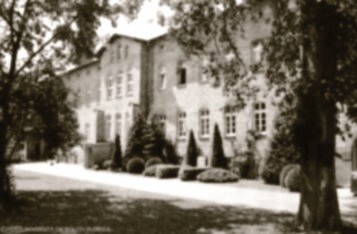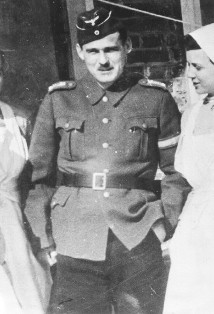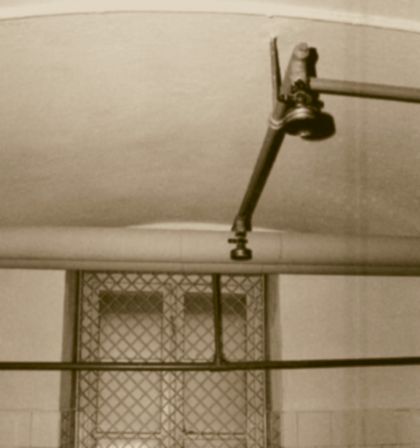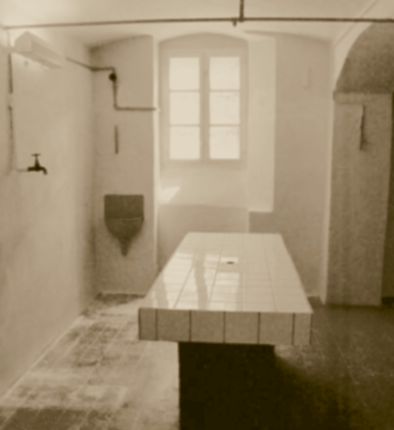Holocaust Education & Archive Research Team |
Euthanasia
Nazi Eugenics & Euthanasia T- 4 Staff T- 4 in Poland T - 4 in Germany & Austria | |||
Bernburg Euthanasia Center
A mental home with a capacity of 132 beds was founded in 1875 in Bernburg, near Magdeburg. As a replacement for Brandenburg, in September 1940 a section of the complex was confiscated by the Gemeinnützige Stiftung für Anstaltspflege (Charitable Foundation for Institutional Care), one of the fake organizations set up to camouflage the euthanasia programme commonly known as Aktion T4. From that time onwards, Bernburg mental home was divided into both a normal institution and a euthanasia killing site. Within four weeks during October/November 1940, 80 square metres of the cellar in the former Männerhaus 2 (Men’s House No.2) were converted into a killing facility. The Brandenburg staff, including physician-in –chief, Dr. Irmfried Eberl, moved as a group to the new killing centre. A small room disguised as a shower room was equipped with a peephole and the walls and floor tiled. In this gas chamber measuring 14 square metres, 8,601 people were killed during Aktion T4. Another room was converted into a crematorium by installing two crematory ovens, with a third room utilised as a dissecting room, and a fourth as a mortuary. A superficial inspection of the victims occurred next, in order to see which plausible cause of death the Bernburg administration could pass on to the deceased’s relatives. The victims were then photographed and led to the gas chamber. After gassing, the corpses were cremated and urns filled with ashes. No attempt was made to identify specific remains. Finally, the urn containing a quantity of ashes, together with a falsified death certificate, was forwarded to the next-of-kin. Victims were killed immediately. Generally, large grey buses brought them to the home, although patients sometimes arrived by train. After examination in one of several ground floor rooms, they were ushered to the basement in groups of 60-75, accompanied by “nurses.” Those having distinctive physical features were marked with a red cross on their back by doctors. After gassing, the two gas chamber doors remained closed for one hour, until the room had been ventilated. Adjoining the gas chamber was the dissection room. After gassing, the corpses bearing the red cross were separated and were subjected to an autopsy. The other bodies were cremated immediately by the stokers or "burners". T4 usually picked members of the SS to serve as stokers. In Bernburg there were seven SS stokers and, for a short time, nine
Under Sonderbehandlung 14f13 (Special Treatment 14f13), about 5,000 persons were killed in Bernburg between 1941 and April 1943. In the main these were Jews from the concentration camps Buchenwald, Flossenbürg, Groß-Rosen, Neuengamme, Ravensbrück and Sachsenhausen. As an example of how the system functioned, on 19 and 20 January 1942, about 214 prisoners were selected at Groß-Rosen and their questionnaires sent to T4 headquarters in Berlin, which then transmitted the list of selected prisoners to Bernburg. On 3 March, Bernburg requested the transfer of the 214 prisoners, and on 6 March, Groß-Rosen replied that the 125 prisoners who remained would be transferred on 23 March (the other prisoners originally selected by then either having died or been deemed capable of working.) The buildings not occupied by T4 continued to operate as a normal mental institution throughout the entire T4 and 14f13 period. Following an order from the WVHA on 27 April 1943, the crematory ovens were dismantled and the T4 personnel transferred to Poland. In 1949, the nurse Anna Maria L. stated that it was still possible to see benches in the basement on which the victims had waited for their “shower", as well as the sprinklers in the gas chamber and the dissecting table. During the course of construction works for the memorial in 1988/89, the peephole in the gas chamber wall and the gas chamber door were uncovered.
Eberl was arrested, but evaded trial by committing suicide in February 1948. He had been succeeded by Dr. Heinrich Bunke, who was succeeded in turn by Dr. Kurt Borm. Only 42 staff appear to have worked at Bernburg during gassing operations, and of that number at least 20 were clerks and secretaries solely occupied with office work. Some members of the Bernburg staff were tried and sentenced, but most were never brought to justice. A number of Aktion Reinhard personnel served at Bernburg, including Rudolf Bär, Johannes Bauch, Max Biala, Helmut Bootz, Werner Borowski, Werner Dubois, Kurt D., Irmfried Eberl, Erwin Fichtner, Herbert Floss, Karl Frenzel, Erich Fuchs, Albert G., Siegfried Graetschus, August Hengst, Gottlieb Hering, Fritz Hirche, Erwin Lambert, Willy Mätzig, Johann Niemann, Josef Oberhauser, Karl Pötzinger, Wenzel Rehwald, Gottfried Schwarz, Fritz Schmidt, Otto Stadie, Franz Stangl and Christian Wirth.
Sources: Friedlander, Henry. The Origins of Nazi Genocide: From Euthanasia to the Final Solution, University of North Carolina Press, Chapel Hill, 1995. Holocaust Historical Society
Copyright: WAG H.E.A.R.T. 2006
|



